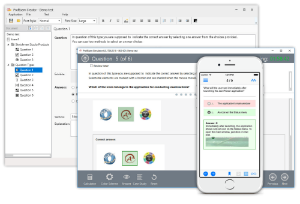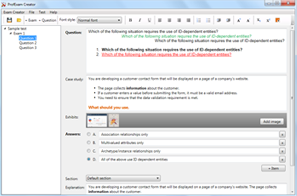File Info
| Exam | Microsoft Azure DevOps Solutions |
| Number | AZ-400 |
| File Name | Microsoft.AZ-400.Dump4Pass.2024-02-04.210q.vcex |
| Size | 11 MB |
| Posted | Feb 04, 2024 |
| Download | Microsoft.AZ-400.Dump4Pass.2024-02-04.210q.vcex |
How to open VCEX & EXAM Files?
Files with VCEX & EXAM extensions can be opened by ProfExam Simulator.
Coupon: MASTEREXAM
With discount: 20%
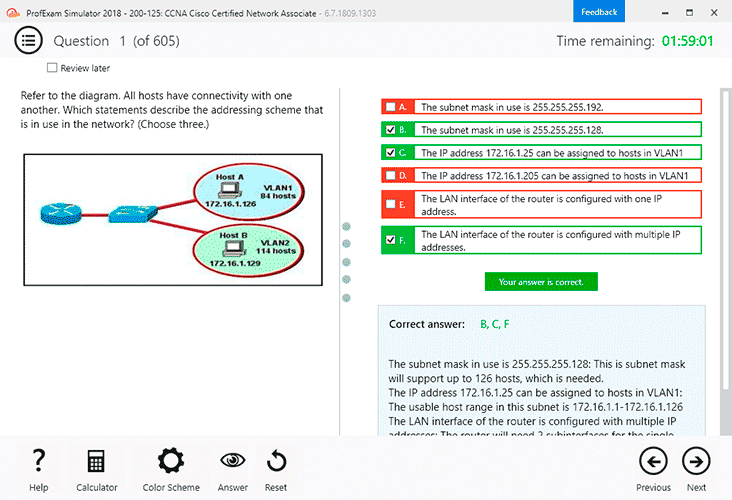
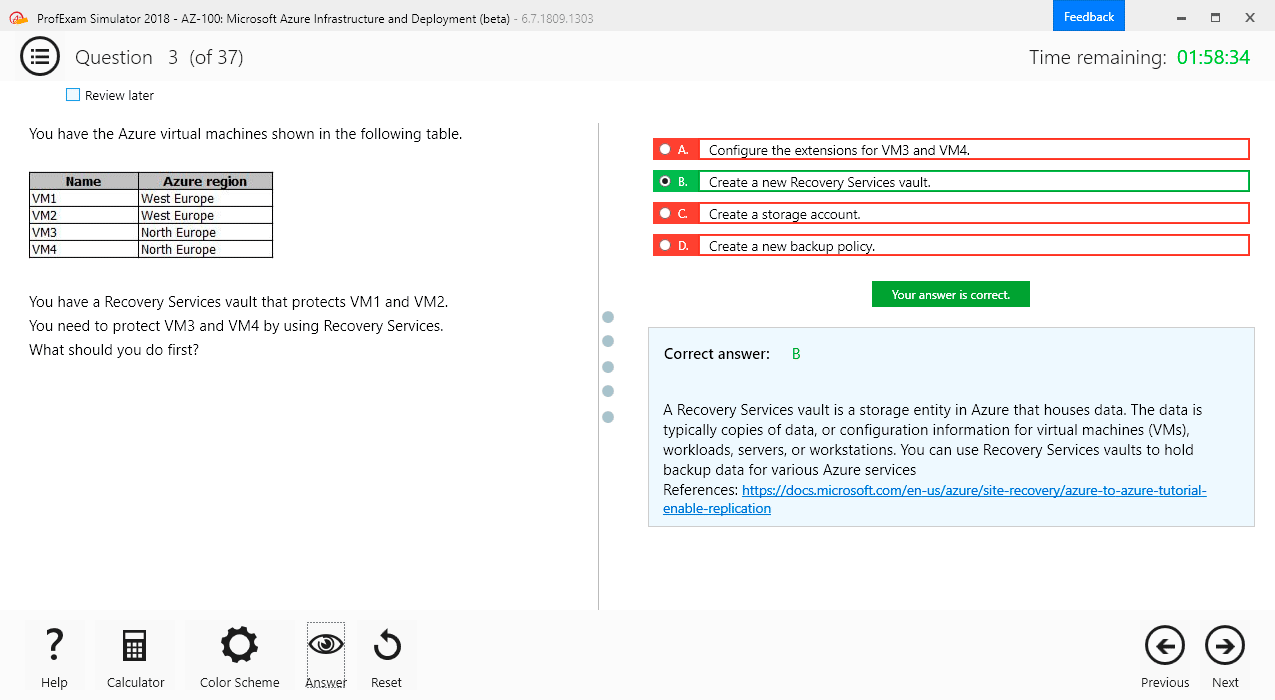
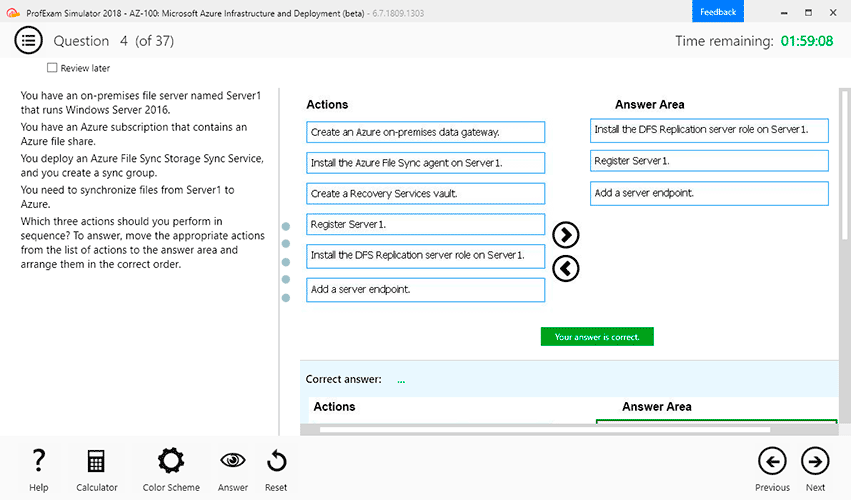
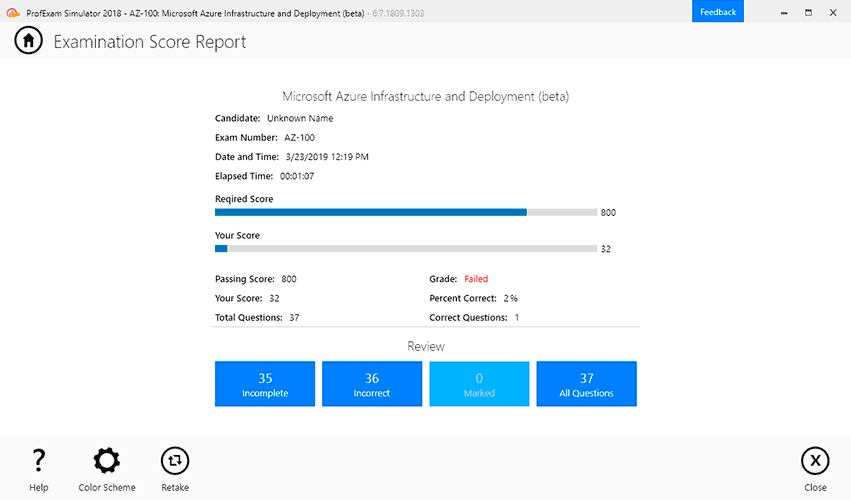
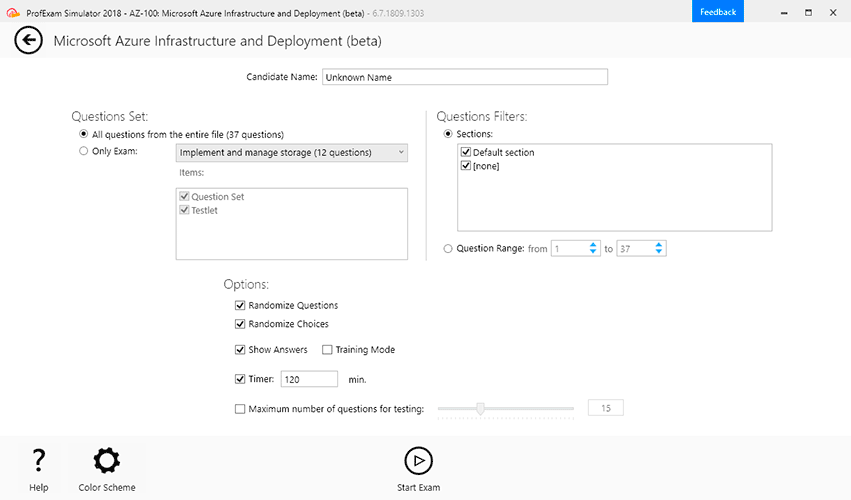
Demo Questions
Question 1
You plan to provision a self-hosted Linux agent.
Which authentication mechanism should you use to register the self-hosted agent?
- personal access token (PAT)
- SSH key
- Alternate credentials
- certificate
Correct answer: A
Explanation:
Note: PAT Supported only on Azure Pipelines and TFS 2017 and newer. After you choose PAT, paste the PAT token you created into the command prompt window. Use a personal access token (PAT) if your Azure DevOps Server or TFS instance and the agent machine are not in a trusted domain. PAT authentication is handled by your Azure DevOps Server or TFS instance instead of the domain controller. Reference: https://docs.microsoft.com/en-us/azure/devops/pipelines/agents/v2-linux Note: PAT Supported only on Azure Pipelines and TFS 2017 and newer. After you choose PAT, paste the PAT token you created into the command prompt window. Use a personal access token (PAT) if your Azure DevOps Server or TFS instance and the agent machine are not in a trusted domain. PAT authentication is handled by your Azure DevOps Server or TFS instance instead of the domain controller.
Reference:
https://docs.microsoft.com/en-us/azure/devops/pipelines/agents/v2-linux
Question 2
You are building a Microsoft ASP.NET application that requires authentication.
You need to authenticate users by using Azure Active Directory (Azure AD).
What should you do first?
- Assign an enterprise application to users and groups
- Create an app registration in Azure AD
- Configure the application to use a SAML endpoint
- Create a new OAuth token from the application
- Create a membership database in an Azure SQL database
Correct answer: B
Explanation:
Register your application to use Azure Active Directory. Registering the application means that your developers can use Azure AD to authenticate users and request access to user resources such as email, calendar, and documents. Reference: https://docs.microsoft.com/en-us/azure/active-directory/manage-apps/developer-guidance-for-integrating-applications Register your application to use Azure Active Directory. Registering the application means that your developers can use Azure AD to authenticate users and request access to user resources such as email, calendar, and documents.
Reference:
https://docs.microsoft.com/en-us/azure/active-directory/manage-apps/developer-guidance-for-integrating-applications
Question 3

You need to ensure that an Azure web app named az400-9940427-main can retrieve secrets from an Azure key vault named az400-9940427-kv1 by using a system managed identity.
The solution must use the principle of least privilege.
To complete this task, sign in to the Microsoft Azure portal.
- See the explanation
Correct answer: A
Explanation:
1. In Azure portal navigate to the az400-9940427-main app. 2. Scroll down to the Settings group in the left navigation. 3. Select Managed identity. 4. Within the System assigned tab, switch Status to On. Click Save. Reference: https://docs.microsoft.com/en-us/azure/app-service/overview-managed-identity 1. In Azure portal navigate to the az400-9940427-main app.
2. Scroll down to the Settings group in the left navigation.
3. Select Managed identity.
4. Within the System assigned tab, switch Status to On. Click Save.

Reference:
https://docs.microsoft.com/en-us/azure/app-service/overview-managed-identity
Question 4
You have an Azure Resource Manager template that deploys a multi-tier application.
You need to prevent the user who performs the deployment from viewing the account credentials and connection strings used by the application.
What should you use?
- Azure Key Vault
- a Web.config file
- an Appsettings.json file
- an Azure Storage table
- an Azure Resource Manager parameter file
Correct answer: A
Explanation:
When you need to pass a secure value (like a password) as a parameter during deployment, you can retrieve the value from an Azure Key Vault. You retrieve the value by referencing the key vault and secret in your parameter file. The value is never exposed because you only reference its key vault ID. The key vault can exist in a different subscription than the resource group you are deploying to. Reference: https://docs.microsoft.com/en-us/azure/azure-resource-manager/resource-manager-keyvault-parameter When you need to pass a secure value (like a password) as a parameter during deployment, you can retrieve the value from an Azure Key Vault. You retrieve the value by referencing the key vault and secret in your parameter file. The value is never exposed because you only reference its key vault ID. The key vault can exist in a different subscription than the resource group you are deploying to.
Reference:
https://docs.microsoft.com/en-us/azure/azure-resource-manager/resource-manager-keyvault-parameter
Question 5

Your company plans to implement a new compliance strategy that will require all Azure web apps to be backed up every five hours.
You need to back up an Azure web app named az400-11566895-main every five hours to an Azure Storage account in your resource group.
To complete this task, sign in to the Microsoft Azure portal.
- See the explanatiob
Correct answer: A
Explanation:
With the storage account ready, you can configure backs up in the web app or App Service. 1. Open the App Service az400-11566895-main, which you want to protect, in the Azure Portal and browse to Settings > Backups. Click Configure and a Backup Configuration blade should appear. 2. Select the storage account. 3. Click + to create a private container. You could name this container after the web app or App Service. 4. Select the container. 5. If you want to schedule backups, then set Scheduled Backup to On and configure a schedule: every five hours 6. Select your retention. Note that 0 means never delete backups. 7. Decide if at least one backup should always be retained. 8. Choose if any connected databases should be included in the web app backup. 9. Click Save to finalize the backup configuration. Reference: https://petri.com/backing-azure-app-service With the storage account ready, you can configure backs up in the web app or App Service.
1. Open the App Service az400-11566895-main, which you want to protect, in the Azure Portal and browse to Settings > Backups. Click Configure and a Backup
Configuration blade should appear.
2. Select the storage account.
3. Click + to create a private container. You could name this container after the web app or App Service.
4. Select the container.
5. If you want to schedule backups, then set Scheduled Backup to On and configure a schedule: every five hours
6. Select your retention. Note that 0 means never delete backups.
7. Decide if at least one backup should always be retained.
8. Choose if any connected databases should be included in the web app backup.
9. Click Save to finalize the backup configuration.

Reference:
https://petri.com/backing-azure-app-service
Question 6

Your company has an Azure subscription named Subscription1. Subscription1 is associated to an Azure Active Directory tenant named contoso.com.
You need to provision an Azure Kubernetes Services (AKS) cluster in Subscription1 and set the permissions for the cluster by using RBAC roles that reference the identities in contoso.com.
Which three objects should you create in sequence? To answer, move the appropriate objects from the list of objects to the answer area and arrange them in the correct order.
Correct answer: To work with this question, an Exam Simulator is required.
Explanation:
Step 1: Create an AKS cluster Step 2: a system-assigned managed identity To create an RBAC binding, you first need to get the Azure AD Object ID. 1. Sign in to the Azure portal. 2. In the search field at the top of the page, enter Azure Active Directory. 3. Click Enter. 4. In the Manage menu, select Users. 5. In the name field, search for your account. 6. In the Name column, select the link to your account. 7. In the Identity section, copy the Object ID. Step 3: a RBAC binding Reference: https://docs.microsoft.com/en-us/azure/developer/ansible/aks-configure-rbac Step 1: Create an AKS cluster
Step 2: a system-assigned managed identity
To create an RBAC binding, you first need to get the Azure AD Object ID.
1. Sign in to the Azure portal.
2. In the search field at the top of the page, enter Azure Active Directory.
3. Click Enter.
4. In the Manage menu, select Users.
5. In the name field, search for your account.
6. In the Name column, select the link to your account.
7. In the Identity section, copy the Object ID.

Step 3: a RBAC binding
Reference:
https://docs.microsoft.com/en-us/azure/developer/ansible/aks-configure-rbac
Question 7
You manage build and release pipelines by using Azure DevOps. Your entire managed environment resides in Azure.
You need to configure a service endpoint for accessing Azure Key Vault secrets. The solution must meet the following requirements:
- Ensure that the secrets are retrieved by Azure DevOps.
- Avoid persisting credentials and tokens in Azure DevOps.
How should you configure the service endpoint? To answer, select the appropriate options in the answer area.
NOTE: Each correct selection is worth one point.
Correct answer: To work with this question, an Exam Simulator is required.
Explanation:
Box 1: Azure Pipelines service connection Box 2: Managed Service Identity Authentication The managed identities for Azure resources feature in Azure Active Directory (Azure AD) provides Azure services with an automatically managed identity in Azure AD. You can use the identity to authenticate to any service that supports Azure AD authentication, including Key Vault, without any credentials in your code. Reference: https://docs.microsoft.com/en-us/azure/devops/pipelines/tasks/deploy/azure-key-vault https://docs.microsoft.com/en-us/azure/active-directory/managed-identities-azure-resources/overview Box 1: Azure Pipelines service connection
Box 2: Managed Service Identity Authentication
The managed identities for Azure resources feature in Azure Active Directory (Azure AD) provides Azure services with an automatically managed identity in Azure AD. You can use the identity to authenticate to any service that supports Azure AD authentication, including Key Vault, without any credentials in your code.
Reference:
https://docs.microsoft.com/en-us/azure/devops/pipelines/tasks/deploy/azure-key-vault
https://docs.microsoft.com/en-us/azure/active-directory/managed-identities-azure-resources/overview
Question 8
Your company is creating a suite of three mobile applications.
You need to control access to the application builds. The solution must be managed at the organization level.
What should you use? To answer, select the appropriate options in the answer area.
NOTE: Each correct selection is worth one point.
Correct answer: To work with this question, an Exam Simulator is required.
Explanation:
Box 1: Microsoft Visual Studio App Center distribution Groups Distribution Groups are used to control access to releases. A Distribution Group represents a set of users that can be managed jointly and can have common access to releases. Example of Distribution Groups can be teams of users, like the QA Team or External Beta Testers or can represent stages or rings of releases, such as Staging. Box 2: Shared Shared distribution groups are private or public distribution groups that are shared across multiple apps in a single organization. Shared distribution groups eliminate the need to replicate distribution groups across multiple apps. Note: With the Deploy with App Center Task in Visual Studio Team Services, you can deploy your apps from Azure DevOps (formerly known as VSTS) to App Center. By deploying to App Center, you will be able to distribute your builds to your users. Reference: https://docs.microsoft.com/en-us/appcenter/distribution/groups Box 1: Microsoft Visual Studio App Center distribution Groups
Distribution Groups are used to control access to releases. A Distribution Group represents a set of users that can be managed jointly and can have common access to releases. Example of Distribution Groups can be teams of users, like the QA Team or External Beta Testers or can represent stages or rings of releases, such as Staging.
Box 2: Shared
Shared distribution groups are private or public distribution groups that are shared across multiple apps in a single organization. Shared distribution groups eliminate the need to replicate distribution groups across multiple apps.
Note: With the Deploy with App Center Task in Visual Studio Team Services, you can deploy your apps from Azure DevOps (formerly known as VSTS) to App Center. By deploying to App Center, you will be able to distribute your builds to your users.
Reference:
https://docs.microsoft.com/en-us/appcenter/distribution/groups
Question 9

You have the following Azure policy.

You assign the policy to the Tenant root group.
What is the effect of the policy?
- prevents all HTTP traffic to existing Azure Storage accounts
- ensures that all traffic to new Azure Storage accounts is encrypted
- prevents HTTPS traffic to new Azure Storage accounts when the accounts are accessed over the Internet
- ensures that all data for new Azure Storage accounts is encrypted at rest
Correct answer: B
Explanation:
Denies non HTTPS traffic. Denies non HTTPS traffic.
Question 10
You have an Azure DevOps organization named Contoso, an Azure DevOps project named Project1, an Azure subscription named Sub1, and an Azure key vault named vault1.
You need to ensure that you can reference the values of the secrets stored in vault1 in all the pipelines of Project1. The solution must prevent the values from being stored in the pipelines.
What should you do?
- Create a variable group in Project1.
- Add a secure file to Project1.
- Modify the security settings of the pipelines.
- Configure the security policy of Contoso.
Correct answer: A
Explanation:
Use a variable group to store values that you want to control and make available across multiple pipelines. Reference: https://docs.microsoft.com/en-us/azure/devops/pipelines/library/variable-groups Use a variable group to store values that you want to control and make available across multiple pipelines.
Reference:
https://docs.microsoft.com/en-us/azure/devops/pipelines/library/variable-groups
